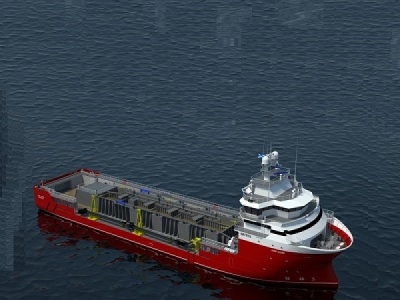
Posted on January 4, 2018
By David Foxwell, OSJ
Working together, naval architects in Europe and the US have developed a proposal to convert excess platform supply vessels into dredgers.
In the wake of the well-documented downturn in the oil and gas markets in recent years, an increasing number of platform supply vessels (PSVs) are currently under-utilised or languishing in layup, most notably in the Gulf of Mexico.
As Dave Pitt, a naval architect at OSD-IMT noted, various proposals have been made for the repurposing redundant PSV tonnage. Examples range from windfarm support vessels to container feeder vessels and live fish carriers, even a recent proposal to convert ice-capable vessels into polar expedition yachts.
However, OSD-IMT and partner Gibbs & Cox have been investigating a different solution – the potential for converting PSVs into trailing suction hopper dredgers (TSHDs).
The OSD-IMT team, part of Offshore Ship Designers (OSD), has designed and built more than 20 dredgers while working with Appledore Shipbuilders in the UK, and Gibbs & Cox has extensive knowledge of the US commercial and military markets.
OSD-IMT has carried out a preliminary assessment focusing on the practicalities of PSV/TSHD conversions from a shipyard perspective, taking account of the technical implications on lightship, vessel structure, and stability. Gibbs & Cox has completed a review of US Coast Guard statutory requirements and other regulations as they apply to the US market, as well as market research into the economic feasibility of such conversions.
The IMT978 PSV design was chosen as the basis for conversion as it best reflects the size and arrangement of the 10-15-year-old candidate vessels identified during Gibbs & Cox research. The IMT978 has conventional shaft propulsion driving controllable pitch propellers via reduction gearboxes with power take-off alternators. The engineroom is situated forward, as is common in North Sea vessels and typical of the newer Gulf Coast vessels.
To accommodate differences between the cargo tank arrangements typically found on North Sea and Gulf Coast PSVs, two variants were considered – the basic IMT978 in its North Sea configuration with cylindrical mud tanks, and a typical Gulf Coast variant with square mud tanks formed with corrugated bulkheads.
A conventional 600 mm dredge system was utilised, providing a 20-25 m dredging depth with an electrically-driven inboard pump. If electrical power is not available in the donor vessel, the dredge pump can be driven by a diesel engine with the incorporation of appropriate fire-suppression requirements. Removal of a section of the safe-haven/cargo rail facilitates fitting of the deck-mounted equipment. The dry bulk tanks and systems can be removed from the vessel and the dredge pump fitted in the vacated space.
A hopper has been introduced on the main deck with a coaming height based on the deck’s existing safe working load of 5 tonnes/m2. The repurposed mud tanks are connected to the deck hopper via new deck openings and are fitted with large ventilation trunks. A centre line bulkhead is incorporated in the deck tank to improve static stability. The hopper is loaded via a single pipe supported on the hopper centre-line bulkhead.
In common with most PSVs, the vessel trims by the head in light loaded conditions. By way of compensation, an aft deck trim tank has been installed which is rapidly filled by the dredge pump and dumped by gravity as cargo is loaded. Cargo dumping is carried out via a conventional bottom door arrangement that utilises the existing double bottom structure.
Due to US environmental controls on bottom door cargo discharge, a cargo pump-out system has also been incorporated, which enables dredge material to be used for other purposes such as wetland creation/restoration and levee maintenance/construction. To support this, a cargo fluidisation system has also been introduced utilising two high-pressure jetting pumps. Analysis by Gibbs & Cox shows that the conversion should be economically viable, but this is clearly dependent on the purchase price of the donor vessel. A comparison has been made between the construction costs of a newbuild 6,300 m3 TSHD and the 2,000 m3 capacity IMT978 conversion concept.
The analysis indicates a payback period of 7.5 years for a newbuild, against six years for a conversion. This takes account of different spoil capacities using a constant cost per cubic metre of dredged material and a constant number of dredge cycles/day.
The per-cubic-metre cost – and initial capital outlay – of a PSV/TSHD conversion is estimated to be approximately half that of a newbuild, while delivery times associated with a conversion should be approximately one-third those of a newbuild. The final reported costs of a recent OSD-IMT dredger conversion project support these findings. “The feasibility study on the proposed conversion of redundant OSV tonnage into dredgers indicates that there are no insurmountable technical or statutory issues involved,” said Mr Pitt. “Economic analysis also suggests that it should be a financially viable option, and such vessels should be competitive in the current dredging market. The relative success of any conversion, of course, will depend on the suitability and purchase cost of the donor vessel.”
Source: osj





